Google Drive UbuntuIntroduction to Google DriveGoogle Drive is a synchronization and file storage service integrated by Google. It was released on 24 April 2012. It permits users to save the file in the cloud, share files, and synchronize files around devices. Google Drive provides applications with offline capabilities for macOS and Windows computers and iOS and Android tablets and smartphones, in inclusion to a web interface. Google Drive encloses Google Slides, Google Sheets, and Google Docs, a segment of the Google Docs Editors office suite that allows collaborative editing of forms, drawings, presentations, spreadsheets, documents, and others. Files edited and created using the Google Docs suite are stored in Google Drive.
Features of Google Drive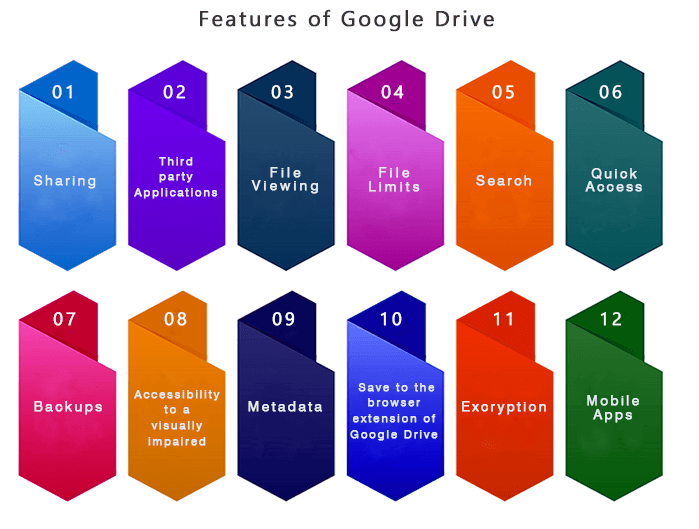
SharingGoogle Drive integrates a file sharing system in which a folder or file creator is its owner by default. The owner can adjust the public visibility of the folder or file. Ownership is interchangeable. The folders or files can be privately shared with specific users who have a Google Account, with an email address related to that account. Also, the folders and files can be made "public on the web", which defines that they can be indexed by finding engines and hence can be accessed and found by anyone. The three different access levels provided are "can view", "can comment", and "can edit". With editing access, users can invite other users to edit. Third-party ApplicationsMany external web applications are available that operate with Google Drive from the Google Web Store. Users are needed for signing into the Google Web Store to add an application, but the applications are compatible with every supported web browser. A few of these applications are first-party, like Google Slides, Sheets, and Docs. Drive applications work on online files and can be applied to create, edit, and view files in several formats, edit videos and images, sign and fax documents, create flowcharts, manage projects, etc. Also, the Drive application can be created as the default to handle file formats which are supported by them. A few of these applications also operate offline on Chrome OS and Google Chrome. File ViewingThe viewer of Google Drive on the web permits the below file formats to be viewed:
In other formats, the file can be managed from third-party applications that operate with Google Drive present from the Chrome web store. File LimitsFiles uploaded, but not transformed into Google Slides, Sheets, or Docs formats, maybe up to 5 TB in size. Also, there are limits specific to a file type, mentioned as follows:
Regardless of the number of font or page size, up to 1.02 million characters are available. Document files can't be larger than 50 MB that are converted into Docs format (.gdoc).
Up to 18,278 columns, or 10 million cells.
Presentation files transformed into .gslides Slides format can't be larger than 100 MB. Inserted images can't be larger than 50 MB and must be non-animated .gif, .png, or .jpg formats. SearchThe results of a search can be narrowed by the open-with app, visibility, ownership, and file type. Users can find images by naming on describing what is in them. For instance, a "mountain" search returns every mountain photo, as well as the text documents of mountains. Text in PDFs and images can be extracted with optical character recognition. Google included "natural language processing" in September 2016 to search on Google Drive, enabling the particular queries of the user search. Google integrated the Google Search and Drive application on Android in February 2017, letting users find keywords, switch to the "In Apps" tab, and check any corresponding Drive files. Quick AccessIn September 2016, it was released in the Android application. It applies machine learning for intelligently predicting the files we require before we have typed anything. This feature was released to be expanded to the web and iOS in March 2017, and the website interface got this feature in May. BackupsGoogle renewed the Android website and app with a section, i.e., "Backups", in December 2016, listing the Android app and device backups stored to Drive. This section lets users check what backups are saved, the details and sizes of the backup, and delete backups. Google disclosed that a new "Backup and Sync" app could synchronize a folder on a computer of the user to Google in June 2017. The app was published on 12 July 2017. Accessibility to a visually impairedGoogle disclosed many updates to Google Drive in June 2014, which added to making the service more usable to visually impaired customers. It added integrated keyboard accessibility, support for high contrast and zooming mode, and screen reader's better compatibility. MetadataThe description field is present for both folders and files that users can utilize to add corresponding metadata. In the description field, content is searchable and indexed by Google Drive. Save to the browser extension of Google DriveGoogle provides an extension for Google Chrome, stored to Google Drive, that permits users to store web content on Google Drive from a browser action or context menu. While images and documents can be directly saved, web pages can be stored in a screenshot form (as an image of a part of the page or the whole page) or as a row Google Docs, MHTML, or HTML file. Users require to be signed into Chrome for using the extension. EncryptionGoogle didn't encrypt data saved on its servers before 2013. Below is information that the National Security Agency of the United States had "direct access" to the servers owned by more than one technology company, such as Google. In July, the company started inspecting encryption data and enabled data encryption between the data centers. However, Google Drive doesn't offer client-side encryption as of 2015. Mobile appsThe primary mobile app of Google Drive supported spreadsheet and document editing until April 2014, when the ability was moved to standalone and separate apps for Google Slides, Google Sheets, and Google Docs. The Google Drive application on Android permits users for taking a photo of the sign, document, or other text and apply optical character recognition for converting to text that could be edited. The Android application, in October 2014, was updated using a Material Design user interface, the ability for adding a custom message when sharing a file, improved search, and a fresh PDF viewer. Platforms of Google DriveGoogle Drive was announced on 24 April 2012, with applications available for Android, macOS, Windows, and a website interface. In June 2012, the iOS application was published later. Computer applicationsGoogle Drive is present for PCs running the 7 or later versions of Windows and Macs executing the OS X Lion or later versions. Google disclosed that a new application, known as "Backup and Sync", will substitute the previous separate Google Photos and Google Drive desktop applications, making a unified application on desktop platforms in June 2017. Originally intended for publication on 28 June, its publication was delayed until 12 July. Google published a new application for Mac and Windows, which is meant to substitute "Drive File Stream" and "Backup and Sync" in July 2021.
Website interfaceGoogle Drive contains a website that permits users to check their files from the internet-connected system without the requirement to install an application. In 2014, the website got a visual overhaul that provided it with a fully new look and developed performance. Also, it simplified a few of the most basic tasks, like clicking just once on any file to check recent activity or distribute the file and included the drag-and-drop functionality, in which users can drag chosen files to folders for developed organization. In August 2016, a new update modified various visual components of the website; the logo was also updated; the design of the search box was renewed, and the primary color was modified from red to blue. Also, it integrated the functionality to locally download files through the website. Now, users can compress and install bigger Drive elements into more than one 2 GB .zip file with a developed naming design, better Google Forms management, and empty folders added in the .zip. Hence, preserving the folder hierarchy of the user. Mobile applicationsGoogle Drive is present for Android tablets and smartphones running Android 4.1 "Jelly Bean" or later versions, and iPads and iPhones running iOS 8 or later versions. Google Drive concluded its support for Android machines running Android 4.0 "Ice Cream Sandwich" or previous versions in August 2016, citing the mobile application of Google update policy. The application will continue to operate for machines running previous versions of Android, but any application updates are given on a best-efforts basis according to the policy. Also, the policy declared a notice would be provided for the planned completion of the service. On 4 May 2020, Google rolled out a new aspect update in its Google Drive application version 4.2020.18204 for iPadOS and iOS, called Privacy Screen, which needs a Touch ID or Face ID authentication whenever the application is open. Storage of Google DriveIndividual user accountGoogle offers every user 15 GB of free storage from Google One. Google Slides, Google Sheets, and Google Docs files don't count the storage limit. Also, this cloud storage is shared with Google Photos and Gmail. Videos at max 1080p resolutions and photos at max 16 megapixels can be stored with the "High-Quality" setting inside Google Photos. The "Original Quality" or "High-Quality" setting applies Google Drive quota. Customers can purchase extra space from either a yearly or monthly payment. The yearly payment option was announced in December 2016, and it is limited to the 100 GB, 200 GB, or 2 TB storage plans. The yearly payments provide a discount. Google disclosed that the storage plans would be shifted to Google One in May 2018. Google WorkspaceGoogle provides 30 GB of Drive storage for every Google Workspace opener customer and endless storage for those utilizing Google Workspace for Organization. For education, the G Suite Workspace is valid for educational universities and institutions in particular-offers 100 TB of storage since July 2022. Universities with 20,000+ Workspace users (staff, students, and related entities) are provided with an optionally enhanced storage limit. Chromebook promotionsThe users of Chromebook can obtain 100 GB of Google Drive storage at no cost for 2 years as long as the advertisement is started within 180 days of the initial purchase of the Chromebook device. It is available in every country in which Google Drive is present. The offer can only be reclaimed once per machine. Refurbished, open-box, and used devices aren't acceptable for the offer. Initially, Google Docs offered 15 GB of free storage before the release of Google Drive. Google Drive was announced with 5 GB of free storage on 24 April 2012. Storage plans were updated with 25 GB at 2.49 dollars per month, 100 GB at 4.99 dollars per month, and 1 TB at 49.99 dollars per month.
Google declared charging for the storage of Google Photos once the customers exceeded the 15 GB limit on their account on 11 November 2020. The update was declared to come into effect from 1 June 2021. Every document and photo uploaded on the online storage of Google will not be counted upon the 15 GB cap before 1 June. Google added a 5 TB storage plan priced at 24.99 dollars per month in September 2021. Installing Google Drive in UbuntuGoogle Drive is a good Cloud Service that permits syncing, sharing, and uploading files by Google around devices. It encompasses many sub-services, for instance, Google Slides, Google Sheets, and Google Docs, that are a part of the office suite. Cloud storage is present for free, but there are many options available for compensated services. In this article, let's see how we can install Google Drive in Ubuntu. Google Drive in UbuntuOfficially, Google provides desktop clients for macOS and Windows due to its immense popularity. It is 2020, and we are yet to receive in an official Google Drive client for Ubuntu. Thankfully, there are ways to have Google Drive on Ubuntu. They are third-party applications. We are going to showcase a few of the best clients we can use to have Google Drive in Ubuntu. These techniques are also very likely to implement on other Ubuntu-based distros. Clients of Google Drive for Linux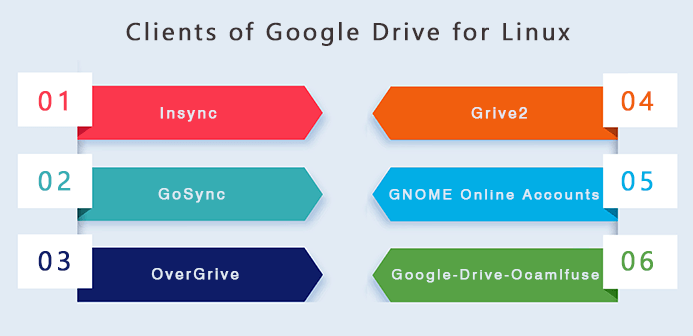
InsyncIt is a powerful client for desktops designed to operate with Microsoft OneDrive and Google Drive. It is a GUI tool available for Linux, macOS, and Windows. It contains multi-account support (OneDrive and Google Drive), selective syncing, and a simple and pleasant user interface. However, unlike many solutions discussed in this article, it provides a price tag. We can enjoy Insync for up to 2 weeks at no cost. If we wish to use it more, we need to unlock it by implementing a one-time purchase. Its pricing is determined by several accounts we wish to use with this tool. Features of Insync
Install Insync Here, we will show how we can install and use the trial version of Insync. If we have bought the product, then all we need is to input the license key manually into the software.
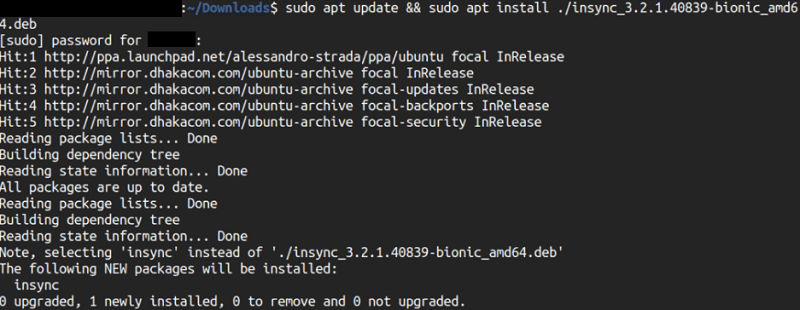
GoSyncGoSync is another best client of Google Drive desktop for Linux. It is specified in Python programming language and provides an easy-to-use GUI. Also, it lets us sync documents and files between remote and local storage like other Google Drive clients. If we make any remote or local modifications, it will sync on both sides automatically, and we can also resume or pause sync whenever we want. Features of GoSync
overGriveWe can enjoy every tool and feature that Insync can provide but only for some dollars. overDrive supports every major Linux distribution and desktop environment. It is simple, and we can install it on any Linux distribution. On the other hand, it works the best on almost all desktop environments, such as LXDE, XFCE, Cinnamon, Unity, KDE, and Gnome Shell. Features of overGrive
Grive2It was a Google Drive client sync for Linux. Now, Grive is available, but Grive2 is there to perform as a client of Google Drive for Linux, which is proposed by Grive. Grive2 supports the partial sync and the new Drive REST API. It is an open-source client of Google Drive Linux, and it operates on most Linux distributions. It is specified in C++, and it uses Google Drive REST API for the tasks. Features of Grive2
GNOME Online AccountsUbuntu applies GNOME as a default desktop environment. GNOME Online Account is a framework (sign-on) for GNOME. It supports famous online services, such as Nextcloud, Microsoft, Facebook, and Google. This technique should be followed if we are utilizing the GNOME desktop. It offers an inbuilt client of Google Drive for Linux. We need to include a Google account in the GNOME online accounts field upon the setting. We can now add, copy, sync, and remove files from the Nautilus file manager. Though it is not a fully-featured client of Google Drive for Linux, we can still implement a few essential tasks. Features of Gnome Online Accounts
With Ubuntu, the tool is pre-installed, so we do not need to worry about manual insulation. If, however, for a few reasons, the application is not installed, then execute the below command to quickly install it: 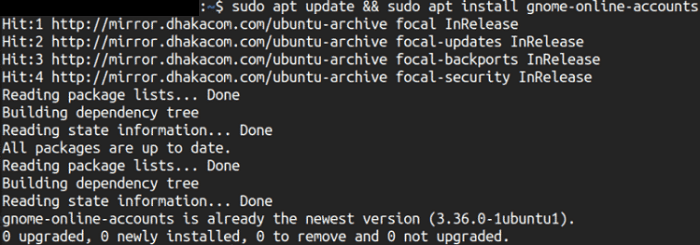
google-drive-ocamlfuseFor Google Drive, google-drive-ocamlfuse is a FUSE filesystem that is specified in OCaml according to the official information. We can mount Google Drive on our system and use it just like a common directory with this tool. Any change made will automatically be synced. google-drive-ocamlfuse features are as follows:
There are many dedicated PPAs for Ubuntu. One for the version, i.e., stable and one for the version, i.e., beta. Here, we will show how to install the first version of google-drive-ocamlfuse. We need to open the terminal window and execute the below commands: 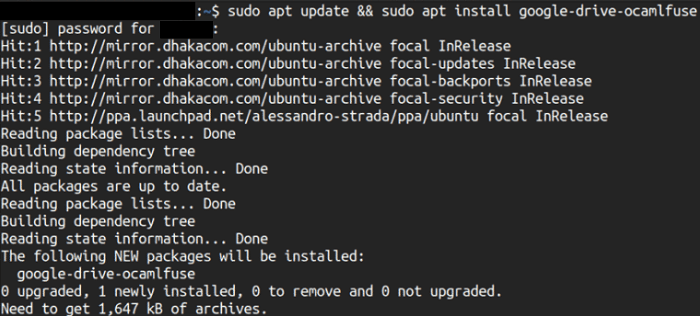
Note: google-drive-ocamlfuse will connect to the directory with the server every 60 seconds. If we have made a modification inside the mounted directory, it will be updated after 60 seconds. Similarly, if any modification is made to the contents of Google Drive from somewhere else, google-drive-ocamlfuse will revise it after a minute locally.
Next TopicInstall ImageMagick Ubuntu
|
 For Videos Join Our Youtube Channel: Join Now
For Videos Join Our Youtube Channel: Join Now
Feedback
- Send your Feedback to [email protected]
Help Others, Please Share









